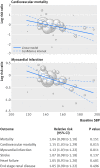Effect of antihypertensive treatment at different blood pressure levels in patients with diabetes mellitus: systematic review and meta-analyses
- PMID: 26920333
- PMCID: PMC4770818
- DOI: 10.1136/bmj.i717
Effect of antihypertensive treatment at different blood pressure levels in patients with diabetes mellitus: systematic review and meta-analyses
Abstract
Objective: To assess the effect of antihypertensive treatment on mortality and cardiovascular morbidity in people with diabetes mellitus, at different blood pressure levels.
Design: Systematic review and meta-analyses of randomised controlled trials.
Data sources: CENTRAL, Medline, Embase, and BIOSIS were searched using highly sensitive search strategies. When data required according to the protocol were missing but trials were potentially eligible, we contacted researchers, pharmaceutical companies, and authorities.
Eligibility criteria: Randomised controlled trials including 100 or more people with diabetes mellitus, treated for 12 months or more, comparing any antihypertensive agent against placebo, two agents against one, or different blood pressure targets.
Results: 49 trials, including 73,738 participants, were included in the meta-analyses. Most of the participants had type 2 diabetes. If baseline systolic blood pressure was greater than 150 mm Hg, antihypertensive treatment reduced the risk of all cause mortality (relative risk 0.89, 95% confidence interval 0.80 to 0.99), cardiovascular mortality (0.75, 0.57 to 0.99), myocardial infarction (0.74, 0.63 to 0.87), stroke (0.77, 0.65 to 0.91), and end stage renal disease (0.82, 0.71 to 0.94). If baseline systolic blood pressure was 140-150 mm Hg, additional treatment reduced the risk of all cause mortality (0.87, 0.78 to 0.98), myocardial infarction (0.84, 0.76 to 0.93), and heart failure (0.80, 0.66 to 0.97). If baseline systolic blood pressure was less than 140 mm Hg, however, further treatment increased the risk of cardiovascular mortality (1.15, 1.00 to 1.32), with a tendency towards an increased risk of all cause mortality (1.05, 0.95 to 1.16). Metaregression analyses showed a worse treatment effect with lower baseline systolic blood pressures for cardiovascular mortality (1.15, 1.03 to 1.29 for each 10 mm Hg lower systolic blood pressure) and myocardial infarction (1.12, 1.03 to 1.22 for each 10 mm Hg lower systolic blood pressure). Patterns were similar for attained systolic blood pressure.
Conclusions: Antihypertensive treatment reduces the risk of mortality and cardiovascular morbidity in people with diabetes mellitus and a systolic blood pressure more than 140 mm Hg. If systolic blood pressure is less than 140 mm Hg, however, further treatment is associated with an increased risk of cardiovascular death, with no observed benefit.
Published by the BMJ Publishing Group Limited. For permission to use (where not already granted under a licence) please go to http://group.bmj.com/group/rights-licensing/permissions.
Conflict of interest statement
Competing interests: All authors have completed the ICMJE uniform disclosure form at
Figures




Comment in
-
Hypertension: When should we treat hypertension in patients with diabetes?Nat Rev Cardiol. 2016 May;13(5):252-3. doi: 10.1038/nrcardio.2016.49. Epub 2016 Apr 7. Nat Rev Cardiol. 2016. PMID: 27053453 No abstract available.
-
Review: In diabetes, benefits of lowering BP depend on baseline BP being 140 mm Hg or more.Ann Intern Med. 2016 Jun 21;164(12):JC62. doi: 10.7326/ACPJC-2016-164-12-062. Ann Intern Med. 2016. PMID: 27323258 No abstract available.
References
-
- Chobanian AV, Bakris GL, Black HR, et al. National Heart, Lung, and Blood Institute Joint National Committee on Prevention, Detection, Evaluation, and Treatment of High Blood Pressure National High Blood Pressure Education Program Coordinating Committee. The Seventh Report of the Joint National Committee on Prevention, Detection, Evaluation, and Treatment of High Blood Pressure: the JNC 7 report. JAMA 2003;289:2560-72. 10.1001/jama.289.19.2560. 12748199. - DOI - PubMed
-
- Mancia G, De Backer G, Dominiczak A, et al. European Society of Hypertension European Society of Cardiology. 2007 Guidelines for the management of arterial hypertension - The task force for the management of arterial hypertension of the European society of hypertension (ESH) and of the European society of cardiology (ESC). Eur Heart J 2007;28:1462-536.17562668. - PubMed
Publication types
MeSH terms
Substances
LinkOut - more resources
Full Text Sources
Other Literature Sources
Medical
